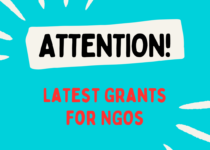Apply for Environmental Education Local Grants Program for Region 8: Complete information on eligibility criteria and application process
Introduction: Apply for Environmental Education Local Grants Program for Region 8, The U.S. Environmental Protection Agency is inviting applications from qualified individuals and organizations to empower grassroots environmental education initiatives. These projects are not just about educating; they are about cultivating environmental stewards, nurturing knowledgeable and responsible students, teachers, and community members.
Through this grant program, we aim to provide essential financial support to endeavors that innovate, demonstrate, or share environmental education practices. These practices are designed to raise awareness about local environmental issues, equipping participants with the knowledge and skills required to make informed decisions and take responsible actions in the realm of the environment.
In an era where threats to human health and environmental well-being grow increasingly intricate, spanning air, water, and land, addressing these challenges is paramount. Environmental issues impact both urban and rural areas, touching the quality of life and economic vitality of our communities. To effectively tackle these complex problems, we must understand our natural and built environment, comprehend the origins of environmental issues, and possess the problem-solving abilities to mitigate them.
Last Date of Application: 8th November 2023
This particular call for proposals focuses on Region 8, encompassing Colorado, Montana, North Dakota, South Dakota, Utah, and Wyoming.
We anticipate awarding three to five grants to projects that will empower communities across this region to become champions of environmental stewardship and knowledge. Together, we can make a lasting impact on our environment and the future of our communities.
Environmental Education Local Grants Program Goals and Objectives
Tackle the Climate Crisis
Objective: Accelerate Resilience and Adaptation to Climate Change Impacts
Take Decisive Action to Advance Environmental Justice and Civil Rights
Objective: Promote Environmental Justice and Civil Rights at the Federal, Tribal, State, and Local Levels
Ensure Clean and Safe Water for All Communities
Objective: Protect and Restore Water bodies and Watersheds
Cross-Agency Strategy 4: Strengthen Tribal, State, and Local Partnerships and Enhance Engagement
Action: Promoting Environmental Education
Environmental Education Local Grants Program Educational and Environmental Priorities
EPA’s Educational Priorities:
- Community Projects:Increasing public understanding of the benefits of and participation in environmental stewardship through community collaboration on issues including, but not limited to climate change, water and soil quality, food waste management, management of ecosystem health and/or local fire or flood prevention. Projects can take place in rural, suburban, and urban settings, in a formal or non-formal educational context, and use outdoor, place-based, experiential, service learning and/or community-focused stewardship activities as the primary teaching tool(s).
- Career Development:Educating students of any age group and/or training their educators or community leaders on how to teach, in formal and non-formal settings, about environmental issues, solutions and stewardship for the purpose of encouraging interest in gratifying careers in one of the environmental fields. These fields include, but are not limited to natural resource conservation and/or managment, climate change, water infrastructure, and water and air quality management.
- Environmental Education Capacity Building:Building the capacity of agencies and organizations to develop, deliver, and sustain comprehensive environmental education programs. Capacity building proposals may focus on one state, multiple states, or a region of the country.
- Environmental Justice:For purposes of this solicitation, Environmental Justice (EJ) refers to activities increasing public awareness and knowledge that disproportionate and adverse environmental, human health, climate-related and other cumulative impacts are more likely to affect or have affected underserved communities. By learning about environmental justice and local environmental issues, program participants will enhance their ability to be meaningfully involved in future EJ discussions that affect their local environments.
- Indigenous Knowledge:Educating project participants on the importance of recognizing, understanding, supporting, and incorporating Indigenous Knowledge into strategies aimed at solving local environmental issues. By enriching environmental education with diverse perspectives and cultivating deep respect for the environment and Indigenous Knowledge holders’ relationship to it, program participants will value both cultural diversity and environmental stewardship.
- EPA’s Environmental Priorities:
- Addressing Climate Change and Improving Air Quality: These efforts help protect the health of all Americans and the ecosystems we depend on by preventing pollution, increasing energy efficiency, improving indoor and outdoor air quality, reducing industrial air pollution and pollution from vehicles and engines, protecting the stratospheric ozone layer, reducing acid rain, and addressing climate change.
- Ensuring Clean and Safe Water:These efforts help ensure that drinking water is clean and safe for all communities. They also contribute to the restoration and maintenance of oceans, watersheds, and their aquatic ecosystems to protect human health, support economic and recreational activities, and provide healthy habitats for wildlife and plants.
- Cleaning Up the Communities by Revitalizing Land and Preventing Contamination:These efforts provide guidelines for safe and environmentally friendly practices in waste management to support cleaning up and restoring land for productive uses and healthy communities. These efforts also lead to a reduction in waste, an increase in reuse, and prevention of environmental contamination.
Environmental Education Local Grants Program Funding Information
- The total amount of funding available under this announcement is approximately $360,000, depending on Agency funding levels, the quality of applications received, agency priorities, and other applicable considerations. It is anticipated that 3-5 awards will be made under this announcement. Each Region 8 grant will be funded for no less than $50,000, and no more than $100,000 in federal funds.
- Applications should plan for projects to start no earlier than July 1, 2024. Applicants should plan for a flexible start date since the date awards are made depends on a variety of factors. Project periods should be proposed for one or two years or any time period between one and two years. The total funding will be the same regardless of the proposed project period (i.e., if a 2-year project is proposed for $100,000, the award amount is $100,000 for the entire two years and no additional funding will be issued for the second year). All project activities must be completed within the negotiated project performance period of between one and two years.
- Applicants may submit more than one application under this solicitation so long as each one is for a different project and is separately submitted.
Environmental Education Local Grants Program Expected Outcomes
Short-Term Outcome:
- Percentage of K-12 students reporting an increase in awareness and knowledge of local environmental issues.
- Percentage of student participants in underserved communities reporting greater feeling of connection to nature.
- Greater understanding of environmental education tools and techniques in context of this grant program’s priorities among mentors and community partners.
- Youth participants’ increased awareness of careers in environmental fields.
- Educators gain perspective on how indigenous knowledge melds with science standards.
Intermediate Outcome:
- Increase in the number of EE instruction hours at participating schools and after school programs.
- Students implement and lead sustainability/EJ-related projects in their schools, homes, and communities, creating innovative solutions to real-world problems.
- Audiences seek additional environmental protection resources from local, regional, and national sources.
- Mentors and community partners develop a greater understanding of how they and local youth can promote indigenous knowledge and environmental stewardship.
- Adoption of pro-environmental behavior by project participants such as changing lifestyle habits, participating in restoration activities, and taking other actions aligned with this grant program’s environmental priorities.
Long-Term Outcome:
- Creation of EE programs in underserved communities.
- Curriculum created by grant funds adopted by counties throughout the state.
- Elimination of barriers to participate in outdoor programming.
- Improved biodiversity.
- Ecosystems become more resilient through their restoration and overall improvement through the implementation of successful managements plans.
Environmental Education Local Grants Program Eligibility Criteria
- Local education agencies
- College or universities
- State education or environmental agencies
- Nonprofit organizations described in Section 501(C)(3) of the Internal Revenue Code
- Tribal organizations that qualify as nonprofit organization
- Tribal education agencies
- Noncommercial educational broadcasting entity as defined and licensed by Federal Communications Commission (FCC)
- Additional eligibility considerations: Applicant organizations must be located in the United States or in U.S. territories. Additionally, eligibility requirements apply to both “prime” recipients and all sub recipients.
Environmental Education Local Grants Program Ineligibility Criteria
- For-profit organizations
- Individual teachers, educators, or faculty members
- Individual students
- Individual citizens
- Individual schools that are not nonprofit
- Tribal education agencies that are administered by the Bureau of Indian Education
- Nonprofit organizations described in Section 501(c)(4) of the Internal Revenue Code that engage in lobbying activities as defined in Section 3 of the Lobbying Disclosure Act of 1995
Reference website link
Hey, STEAL our Best Premium Content For Absolutely Free, Check Out the Links below
HOPE these will add value to your existing skills and knowledge
Our information bears no cost (it’s absolutely FREE), don’t let valuable information slip away.
Join our community of avid readers who are always in the know. Subscribe to our website; stay connected and engaged with the latest news, trends, and developments by subscribing today.
(PUSH the bell ICON)
Leverage the power of knowledge to propel your organization to new heights. Don’t miss out – explore our content
- Latest Funds for NGOs,
- NGO Jobs
- Resources (Helpful Guides and Courses)
- Premium Resources
- NGO related articles
Empowering Humanity through Funds, Resources and Collective Action
Sharing is Appreciated



